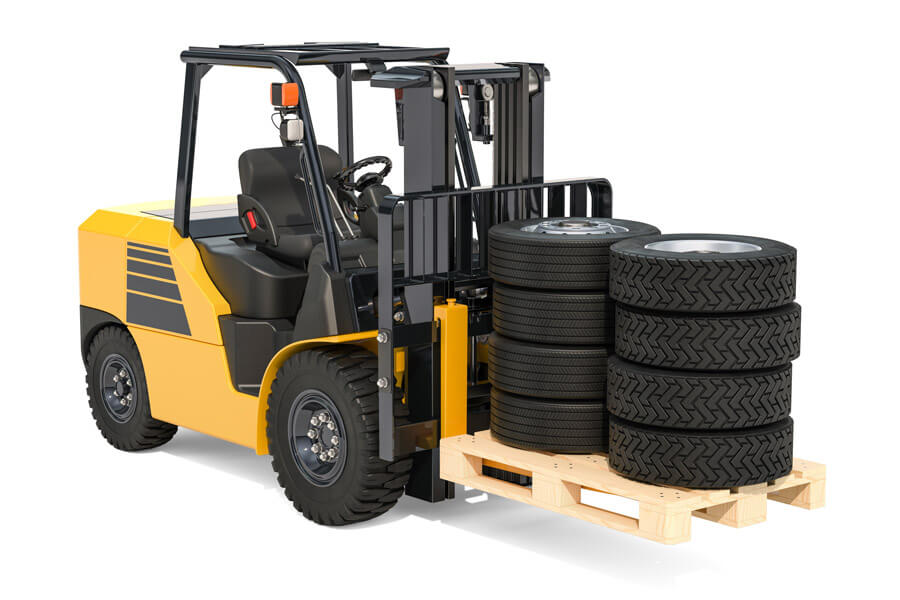Big (forklift) wheels keep on turning, turning. So, here’s everything you need to know about pneumatic wheels and the best times to use them.
Remember when you were a kid (or, maybe recently, when you were a big kid), and you blew up a balloon, pinched the neck tightly, and released it to let the balloon whoosh around the room. Well, in addition to being awesome, that was likely your first introduction to pneumatics.
Pneumatic systems use pressurized air (or gas, like nitrogen) to transmit force and energy. For example, a jackhammer is also known as a pneumatic drill because they use compressed air to quickly move a heavy metal piece up and down to blast cement apart. However, the job of a tire is radically different from a jackhammer. So, if you’re wondering, “what does pneumatic tires mean?” read on.
What does the term pneumatic tires mean?
When we call a tire pneumatic, we’re simply saying that it’s filled with pressurized air. The outside of pneumatic tires is thick tread-molded rubber typically reinforced by steel belting. Underneath the rubber is layers of rubber-coated polyester, known as “plies.” The inside of the tire is an airtight core filled with pressurized air.
So, that’s fascinating, but did you answer the question, “what are pneumatic tires?”
Funny enough, you already know what pneumatic tires are, even if you didn’t realize they were pneumatic tires.
Not only are pneumatic tires found on high-capacity, all-terrain, and industrial forklifts, but they’re likely on your vehicle right now. Yes, all air-filled tires are pneumatic tires meaning they’re the everyday, inflatable tires you know and love (or hate, like when you accidentally drive over a nail).
An easy way to spot pneumatic tires is to look for the valve used to fill them with air. Solid tires do not need a valve.
What’s truly impressive about pneumatic wheels is that they remain inflated even with the weight of a 3,000- to 20,000-pound forklift bearing down on them. The reason this happens, in short, is because the air pressure inside the tire is greater than the air pressure outside of it. The inside pressure pushes outward, keeping the tire rigid and stable. That’s why, when the pressure is too low, the tire sags.
What’s the benefit of an air tire?
There are several advantages to using pneumatic tires.
Exceptional shock absorption. For those times when you need a smooth ride over rough terrain (such as when driving a forklift that’s carrying a full load), pneumatic wheels absorb the bumps and jolts of uneven ground. The shock absorption also provides a more comfortable ride for forklift operators, and avoiding hammering blows to the complex inner working of your equipment extends its longevity.
Protects floors. Despite the heavy equipment they support (plus the hefty loads they carry), the natural give of pneumatic tires helps prevent scratches, divots, and other damage to flooring.
Suitable for multiple environments. There are a wide variety of tread patterns for pneumatic wheels. Whether the job site is off-road, on pavement, or a combination of both, there are pneumatic tires fit for the job.
Provides the right tire for the right job. In addition to the wide range of tread options, you can also choose between bias-ply and radial tires. The difference between the two is their construction. In bias-ply, the plies (the polyester material under the tread) weave throughout the entire tire in an angled, overlapping pattern. For radial tires, the plies stack in a 90-degree pattern only along the center of the tire. Radials provide better traction, more comfort, and better handling than bias-ply. However, bias tires typically cost less and have thicker, more puncture-resistant sides.
The best uses for pneumatic tires
Pneumatic wheels are ideal for job sites with uneven terrains, such as construction sites, pothole-riddled areas, and gravel-filled or sandy locations. You may also opt for pneumatic tires when comfort is a priority for you and your forklift operators.
So, the next time someone asks you, “What is a pneumatic tire?” you can talk their ear off. For more info on all parts for your forklifts—including pneumatic tires, forklift batteries, and all accessories—give Texas Motive Solutions a call at (888) 316-2459. Our forklift repair service team is happy to answer all of your questions. Please fill out a form to learn about our services and discover everything we can do for you.



